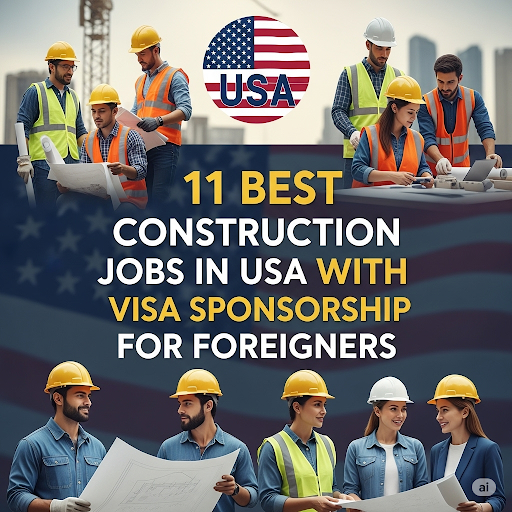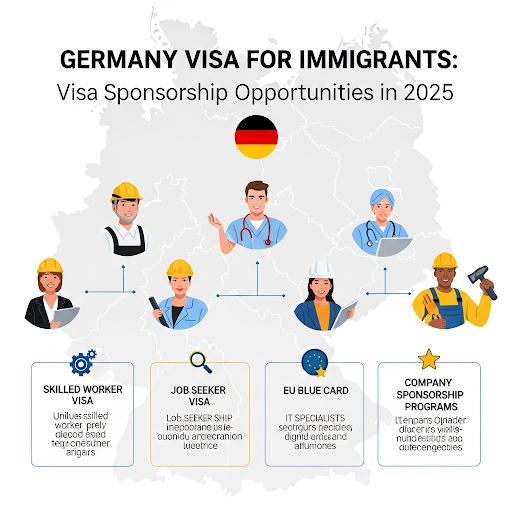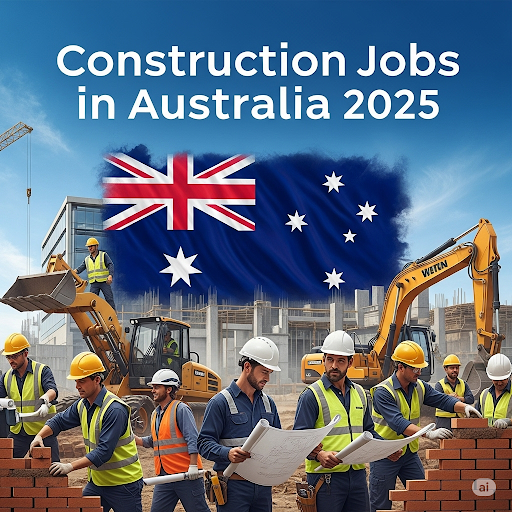The United States stands as a prime destination for foreign workers seeking opportunities in the construction industry, particularly with visa sponsorship.
With a booming economy and an estimated $1.5 trillion in construction projects underway or planned, including infrastructure revitalization and housing developments, the demand for skilled labor has surged.
This demand, coupled with a persistent labor shortage—projected at over 500,000 workers by the Associated General Contractors of America (AGC)—has led many U.S. construction firms to sponsor foreign workers.
This comprehensive article explores the economic context, the 11 best construction jobs with visa sponsorship, eligibility criteria, visa options, application strategies, living conditions, challenges, and future outlook, providing a detailed roadmap for foreigners aiming to build a career in the U.S. construction sector.
Economic Context and Demand for Construction Workers
The U.S. economy, with a Gross Domestic Product (GDP) of approximately $28 trillion in 2025, relies heavily on its construction industry, which contributes over $1.4 trillion annually.
This sector encompasses residential, commercial, and infrastructure projects, driven by government investments (e.g., the $1.2 trillion Infrastructure Investment and Jobs Act) and private development.
However, the industry faces a critical labor shortage, with the AGC reporting that 80% of contractors struggle to fill positions due to an aging workforce, low apprenticeship enrollment, and immigration restrictions.
This gap has opened doors for foreign workers, with companies increasingly offering visa sponsorship to attract talent.
The shortage is most acute in skilled trades, where wages have risen to reflect demand—ranging from $20 to $40 per hour, or $41,600 to $83,200 annually, with overtime and benefits pushing totals higher. States like Texas, California, and Florida, with major projects such as the Interstate 35 expansion and high-rise developments, are hotspots for hiring.
The cultural diversity of the workforce, with over 1.5 million foreign-born construction workers (per the Bureau of Labor Statistics), further supports integration, making the U.S. an attractive destination for skilled foreigners.
11 Best Construction Jobs with Visa Sponsorship
The following 11 construction jobs are in high demand, offer competitive salaries, and are eligible for visa sponsorship based on industry trends and employer needs. Each role includes typical duties, salary ranges, and demand drivers:
1. Construction Manager
- Salary Range: $80,000 – $150,000+ annually
- Responsibilities: Oversee project planning, budgeting, and compliance with safety regulations, coordinating teams of workers and subcontractors.
- Demand Drivers: Large-scale infrastructure projects and commercial developments require experienced managers. Companies like Bechtel and Fluor often sponsor for this role.
2. Civil Engineer
- Salary Range: $75,000 – $130,000+ annually
- Responsibilities: Design and supervise construction of infrastructure like roads, bridges, and water systems, ensuring structural integrity.
- Demand Drivers: Government infrastructure spending and urban expansion fuel demand, with firms like Jacobs Engineering seeking sponsored talent.
3. Electrician
- Salary Range: $50,000 – $100,000+ annually
- Responsibilities: Install, maintain, and repair electrical systems in buildings and infrastructure, often specializing in renewable energy setups.
- Demand Drivers: The shift to green energy and residential construction boosts needs, with sponsorship from companies like Siemens Energy.
4. Plumber
- Salary Range: $45,000 – $90,000+ annually
- Responsibilities: Install and repair plumbing systems, including pipes and fixtures, with opportunities in industrial projects.
- Demand Drivers: Housing shortages and commercial builds drive demand, with some firms offering H-2B sponsorship.
5. Carpenter
- Salary Range: $40,000 – $80,000+ annually
- Responsibilities: Construct and repair wooden structures, including formwork and cabinetry, often working on custom homes.
- Demand Drivers: A national housing deficit of 200,000 units sustains demand, with regional firms sponsoring workers.
6. Heavy Equipment Operator
- Salary Range: $45,000 – $85,000+ annually
- Responsibilities: Operate machinery like bulldozers and cranes, essential for site preparation and large-scale projects.
- Demand Drivers: Mining and highway construction projects, especially in the Midwest, increase needs, with sponsorship options.
7. Bricklayer/Stonemason
- Salary Range: $40,000 – $75,000+ annually
- Responsibilities: Build walls and structures using bricks or stone, with stonemasons handling heritage restoration.
- Demand Drivers: Urban redevelopment and residential growth, particularly in the Northeast, support sponsorship.
8. Welder
- Salary Range: $45,000 – $90,000+ annually
- Responsibilities: Join metal components, specializing in pipelines or structural work, often in hazardous environments.
- Demand Drivers: Energy sector projects, like those in Texas, drive demand, with H-2B visas commonly used.
9. Construction Laborer
- Salary Range: $30,000 – $60,000+ annually
- Responsibilities: Perform manual tasks like site cleanup, material handling, and basic construction support.
- Demand Drivers: General labor shortages across all project types make this role sponsorable, especially seasonally.
10. Roofing Contractor
- Salary Range: $40,000 – $80,000+ annually
- Responsibilities: Install and repair roofs, specializing in commercial or residential properties, often working at heights.
- Demand Drivers: Weather-related repairs and new construction in hurricane-prone states like Florida support sponsorship.
11. Project Engineer
- Salary Range: $70,000 – $120,000+ annually
- Responsibilities: Support project managers with technical designs, cost estimates, and coordination with engineers.
- Demand Drivers: Complex infrastructure projects require technical expertise, with sponsorship from firms like Kiewit.
These jobs span skilled and semi-skilled categories, with salaries varying by experience, location (e.g., higher in Alaska or New York), and overtime. Visa sponsorship is more common for roles requiring specific skills (e.g., engineers, electricians) or where labor shortages are severe (e.g., laborers, roofers).
Eligibility Criteria
To qualify for these construction jobs with visa sponsorship, foreigners must meet the following criteria:
- Work Experience: 2-5 years of relevant experience is preferred, though laborers and helpers may require less (6-12 months). Specialized roles like engineers need advanced credentials.
- Education: A high school diploma or equivalent is sufficient for laborers and trades, while engineers and managers typically need a bachelor’s degree or trade certification (e.g., OSHA certification).
- Language Skills: Conversational English (e.g., TOEFL iBT 61 or IELTS 5.5) is required, with higher proficiency (IELTS 6.5) needed for managerial roles.
- Skills and Certifications: Trade-specific certifications (e.g., NCCER for carpenters, AWS for welders) enhance eligibility. Safety training (e.g., OSHA 10-hour course, $100-$200) is often mandatory.
- Health and Character: A medical exam and police clearance are required for visa approval, ensuring no communicable diseases or criminal history.
- Employer Support: A job offer from a U.S. employer willing to sponsor is critical, as construction is not a guaranteed shortage occupation.
Visa Options for Sponsorship
Foreign workers can pursue several visa types for construction jobs, depending on the role and employer:
H-2B Visa (Temporary Non-Agricultural Workers)
- Description: For temporary or seasonal construction jobs (e.g., laborers, roofers) where U.S. workers are unavailable.
- Duration: Up to 9 months, renewable with a 66,000 annual cap.
- Requirements: Employer petition (Form I-129, $460), labor certification, and job offer. Fees total $645-$1,000.
- Suitability: Ideal for short-term projects or seasonal work.
H-1B Visa (Specialty Occupations)
- Description: For skilled roles like engineers or managers requiring a bachelor’s degree or equivalent.
- Duration: 3 years, renewable to 6, with a 85,000 annual cap (including 20,000 for advanced degrees).
- Requirements: Employer petition, labor condition application, and degree proof. Fees start at $1,500-$2,000.
- Suitability: Best for technical or supervisory positions.
TN Visa (NAFTA Professionals)
- Description: For Canadians and Mexicans in roles like engineers or project managers under the USMCA.
- Duration: Up to 3 years, renewable indefinitely.
- Requirements: Job offer, degree or license, and $50 application fee.
- Suitability: Limited to North American applicants.
E-2 Visa (Treaty Investor)
- Description: For nationals of treaty countries investing in a U.S. construction business (e.g., starting a contracting firm).
- Duration: Renewable indefinitely with active business.
- Requirements: $100,000+ investment, business plan, and $205 fee.
- Suitability: For entrepreneurial workers.
O-1 Visa (Extraordinary Ability)
- Description: For highly skilled workers (e.g., innovative engineers) with proven acclaim.
- Duration: Up to 3 years, renewable.
- Requirements: Evidence of awards or recognition, employer petition ($460).
- Suitability: Rare but possible for top talent.
The H-2B visa is most common for trades, while H-1B suits skilled professionals. Employers must demonstrate a lack of U.S. workers, a process facilitated by the Department of Labor.
Application Strategies
Securing a sponsored construction job requires a strategic approach:
- Research Employers: Target firms like Bechtel, Fluor, Kiewit, and Turner Construction, known for hiring internationally. Check Indeed, LinkedIn, and AGC job boards.
- Prepare Documents: Obtain a passport, resume with construction experience, certifications, and English test results. A cover letter emphasizing skills and willingness to relocate is key.
- Network: Attend construction expos, join online forums (e.g., r/construction on Reddit), or connect with recruiters via LinkedIn. Cold emails to HR departments can yield results.
- Apply Directly: Submit applications online or in-person, highlighting relevant experience and safety training. Follow up within a week.
- Seek Agencies: Use recruitment firms specializing in U.S. construction (e.g., Manpower, Randstad), which often handle visa processes for a fee ($500-$2,000).
Persistence and targeting high-demand regions (e.g., Texas, California) increase success rates.
Living Conditions
Living costs vary by location. In Houston, rent for a one-bedroom apartment averages $1,200/month, while in rural areas like Idaho, it’s $800. Public transport costs $50-100/month, and groceries range from $300-400/month.
Construction workers benefit from union support (e.g., United Union of Roofers), ensuring fair wages and safety. The multicultural workforce, with 13% foreign-born residents, aids integration, though English proficiency is essential. Healthcare costs ($300-500/month uninsured) are a concern, but some employers offer plans.
Benefits of Working with Visa Sponsorship
- Legal Work Status: Ability to live and work in the U.S. for the visa duration.
- Career Advancement: Opportunities to move to supervisory or engineering roles.
- Financial Stability: Competitive wages with overtime potential.
- Path to Permanency: Possible transition to green cards with employer support (e.g., EB-3).
Challenges and Mitigation
- Visa Costs: Fees ($645-$2,000) and legal assistance ($1,000-$5,000) are significant. Save ahead or negotiate employer coverage.
- Labor Shortage Proof: Employers must justify hiring foreigners, requiring patience during certification. Target firms with a history of sponsorship.
- Physical Demands: Outdoor work in extreme weather is taxing. Maintain fitness and safety training.
- Cultural Adjustment: Adapting to U.S. work culture (e.g., punctuality, direct communication) takes time. Engage with expat communities.
- Job Security: Temporary visas like H-2B may end. Seek employers offering H-1B or green card paths.
Future Outlook
The construction industry is expected to grow by 5-7% annually through 2030, driven by infrastructure ($500 billion in federal funds) and housing needs. The labor shortage may lead to increased H-2B caps or new visa categories, though political debates on immigration could impact policies.
Automation (e.g., robotic bricklayers) may reduce some labor roles, but skilled trades will remain essential. Monitoring updates from the U.S. Department of Labor and industry reports will be vital.
Frequently Asked Questions (FAQs)
1. What construction jobs in the USA offer visa sponsorship for foreigners?
The 11 best construction jobs with visa sponsorship include Construction Manager, Civil Engineer, Electrician, Plumber, Carpenter, Heavy Equipment Operator, Bricklayer/Stonemason, Welder, Construction Laborer, Roofing Contractor, and Project Engineer. These roles are in high demand and eligible for sponsorship based on labor shortages and employer needs.
2. Do I need to speak English to work in these jobs?
Yes, conversational English is required (e.g., TOEFL iBT 61 or IELTS 5.5), with higher proficiency (IELTS 6.5) needed for skilled roles like engineers or managers. Employers and visa programs assess language ability to ensure workplace communication, though some offer training support.
3. What qualifications are needed for these construction jobs?
Requirements vary: laborers and trades (e.g., carpenters, welders) need a high school diploma or equivalent and 2-5 years of experience, often with trade certifications (e.g., NCCER, AWS). Engineers and managers typically require a bachelor’s degree. Overseas qualifications must be validated by U.S. authorities.
4. How long does the visa process take?
Processing times depend on the visa: H-2B takes 2-4 months, H-1B 4-6 months (due to the annual lottery), TN 1-2 months, E-2 3-6 months, and O-1 2-4 months. Delays can occur due to employer petitions or background checks, so early application is advised.
5. Can I bring my family with me on a work visa?
Yes, dependents (spouse and children under 21) can apply for derivative visas (e.g., H-4 for H-1B/H-2B), but they cannot work unless they secure their own work authorization. Additional fees apply (e.g., $460 per dependent), and they must meet health and character requirements.
6. What is the minimum salary for sponsored construction jobs?
There is no fixed minimum, but the prevailing wage for the job location must be met (e.g., $20-$40/hour for trades, $30-$50/hour for skilled roles), as determined by the Department of Labor. Salaries often exceed this, with many jobs offering $80,000+ annually with overtime.
7. Do I need a job offer before applying for a visa?
Yes, a job offer from a U.S. employer willing to sponsor is required for all visa types (H-2B, H-1B, TN, E-2, O-1). The employer must file a petition and, for H-2B/H-1B, obtain a labor certification proving no U.S. workers are available.
8. What are the costs involved in getting a work visa?
Costs include visa fees ($205-$1,500 depending on type), employer petition fees ($460-$2,000), labor certification ($300-$1,000), medical exams ($200-$500), and optional legal assistance ($1,000-$5,000). Total costs can range from $1,500-$10,000, often shared with employers.
9. Can I stay permanently after getting a work visa?
Temporary visas (H-2B, H-1B) allow stays of 9 months to 6 years, with potential for green card sponsorship by employers (e.g., EB-3 for skilled workers). Permanent residency requires a separate process, typically taking 1-3 years with employer support.
10. What if my qualifications are from another country?
Overseas qualifications must be evaluated by a credentialing agency (e.g., World Education Services, $200-$300) and may require additional training or certification (e.g., OSHA 10-hour course, $100-$200) to meet U.S. standards. This process takes 1-3 months.
11. Are there age restrictions for these visas?
There is no upper age limit for most visas, but applicants must be at least 18. H-1B and O-1 favor younger workers with recent degrees, while H-2B and TN have no specific age bias, though physical fitness for trades is assumed.
12. How can I find employers willing to sponsor?
Research companies like Bechtel, Fluor, Kiewit, and Turner Construction, known for international hiring. Use job boards (Indeed, LinkedIn), attend construction expos, or contact recruiters. Firms in high-demand states (e.g., Texas, California) are more likely to sponsor.
13. What if my visa application is rejected?
Rejections may occur due to incomplete documentation, insufficient job offer proof, or health issues. Appeal within 30 days ($630 fee) or reapply after addressing deficiencies. Consult an immigration attorney for guidance.
14. What support is available for new arrivals?
New arrivals can access settlement services through the Office of Refugee Resettlement or community organizations, offering language classes, job training, and housing assistance. Unions like the United Union of Roofers provide additional support.
15. How does the labor shortage affect my chances?
The severe labor shortage (500,000+ workers) increases employer willingness to sponsor, especially for trades like electricians and welders. However, caps on H-2B (66,000) and H-1B (85,000) visas create competition, so targeting uncapped options (e.g., TN) or off-peak application times can help.
Conclusion
The 11 best construction jobs in the USA with visa sponsorship—ranging from construction managers to laborers—offer foreigners a pathway to a stable and rewarding career. With a robust demand, viable visa options like H-2B and H-1B, and a supportive industry environment, opportunities abound.
By meeting eligibility criteria, employing strategic applications, and navigating challenges with planning, international workers can secure these roles. As the U.S. continues to invest in its infrastructure, now is the opportune moment to pursue these jobs—research, apply, and build your future in America.






